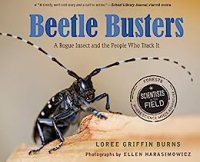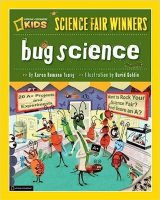
When you study entomology, you see you’re not just looking at bugs and their behaviors (also fascinating enough) . . . you discover the people who spent their lives studying them, how insects adapted to endure and thrive, and the ways insects impact our lives. Here are some ways to challenge students to explore lives of insects and the people who study them.
 Insects and Arachnids (Field Guides) by Carla Mooney
Insects and Arachnids (Field Guides) by Carla Mooney
After defining each and their roles in nature, vivid photographs accompany descriptions and fascinating side bars, as well as “How to Spot” and “Fun Facts” sections for each insect, spider, and other critter. Easily browsable, it is divided into the categories: True Flies, Beetles, Wasps and Bees, Ants, Moths and Butterflies, True Bugs, Spiders, Ticks and Mites, and Scorpions.
Student Activity
Make an Insect Identification Journal. Use this field guide out in the field and record any identified insects in your journal. Separate your entries by date and take photos or make sketches of the insects you see. Record the weather, the area where seen, and the insect’s common and scientific names.
 Naturalist: A Graphic Adaptation by Edward O. Wilson and Jim Ottaviani, illustrated by C.M. Butzer
Naturalist: A Graphic Adaptation by Edward O. Wilson and Jim Ottaviani, illustrated by C.M. Butzer
E.O. Wilson is an insatiably curious biologist, well-known for his work on ants and insect societies. He reminisces about childhood expeditions to the creek with friends, and an effort to collect and study “all the ants in a vacant lot.” Ants may be small, but examining their societies led Wilson to ask big questions about social structure, genetics, and biogeography.
Student Activity
A Day in an Ant’s Life Comic. Craft a three-panel comic about an ant’s life. Think of a short narrative arc that can stretch ver three panels. Write the text of your comic. Sketch the panels to go along with your text. Revise after getting some feedback, and then color an complete your comic. (Extra points if you can fit in an interesting adaptation!)
 Buzzing with Questions: the Inquisitive Mind of Charles Henry Turner by Janice N. Harrington, illustrated by Theodore Taylor III
Buzzing with Questions: the Inquisitive Mind of Charles Henry Turner by Janice N. Harrington, illustrated by Theodore Taylor III
At a time when most colleges didn’t accept black students, Charles Turner went to study zoology. He had a particular fondness for small creatures, insects, and used them to help answer big questions: how do ants find their way home? Can an insect solve a maze? Can bees learn to identify colors? This book will inspire emerging entomologists of all ages.
Student Activity
Ask Like a Scientist. Charles Henry Turner asked lots of questions. All scientists do. See what questions you have about an ant’s body. Find a photo of an interesting kind of ant. Then study its body. Does it have strong jaws? Does it have little hairs? Is it tiny or huge? Label the parts that make you wonder with a question you want answered. Then do some research to find answers to add.
 Moth: An Evolution Story by Isabel Thomas, illustrated by Daniel Egnéus
Moth: An Evolution Story by Isabel Thomas, illustrated by Daniel Egnéus
One of the most remarkable stories about natural selection is that of how the pepper moth adapted to the sooty pollution of the industrial revolution. Evolution is a big concept, hard to grasp sometimes, and this book does a marvelous job telling – and showing – how environmental changes affect insect populations. A picture book for the 8-10 crowd.
Student Activity
The Perfect Insect. Insects have evolved in all kinds of ways—some fly, some hop, some squirm and some swim. They can be iridescent and delicate or brown and solid. These colors, forms, and behaviors are all adaptations that occurred over time to help them survive. Design your perfect insect. How will it move? What colors will it have? How will its features help it survive in its habitat? Figure out all the parts of your insect and then draw it.Don’t forget to give it a name, too!
 Karen Latchana Kenney loves to write books about animals, and looks for them wherever she goes—from leafcutter ants trailing through the Amazon rain forest in Guyana, where she was born, to puffins in cliff-side burrows on the Irish island of Skellig Michael. She especially enjoys creating books about nature, biodiversity, conservation, and groundbreaking scientific discoveries—but also writes about civil rights, astronomy, historical moments, and many other topics. Visit her at https://latchanakenney.wordpress.com
Karen Latchana Kenney loves to write books about animals, and looks for them wherever she goes—from leafcutter ants trailing through the Amazon rain forest in Guyana, where she was born, to puffins in cliff-side burrows on the Irish island of Skellig Michael. She especially enjoys creating books about nature, biodiversity, conservation, and groundbreaking scientific discoveries—but also writes about civil rights, astronomy, historical moments, and many other topics. Visit her at https://latchanakenney.wordpress.com































